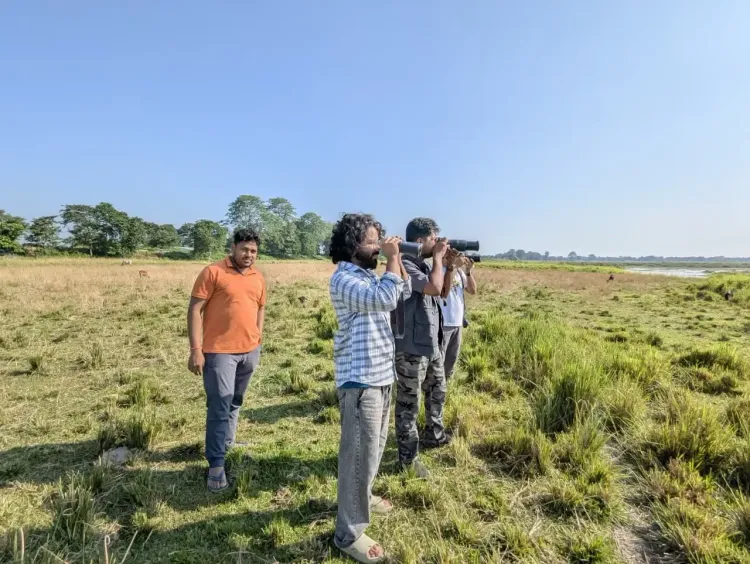What Did Assam’s Kaziranga Discover During Its Latest Bird Survey?

Synopsis
Key Takeaways
- Kaziranga National Park is a UNESCO World Heritage site.
- The latest bird survey recorded 146 species and 1,919 individual birds.
- Agoratoli showed the highest diversity with 89 species.
- Community participation was crucial in the success of the survey.
- Endangered species like the Swamp Grass Babbler were documented.
Guwahati, Oct 19 (NationPress) Kaziranga National Park and Tiger Reserve (KNPTR), recognized as India's seventh UNESCO World Heritage site, has successfully documented 146 bird species and 1,919 individual birds during its recent bird survey, officials reported on Sunday.
A senior official indicated that the ‘Kati Bihu Bird Count 2025’ was effectively conducted at Kaziranga on Saturday, organized by the Assam Bird Monitoring Network (ABMN) in partnership with the KNPTR authorities.
The KNPTR official explained that the bird surveys spanned five critical locations: Panbari Range, Laokhowa Wildlife Sanctuary, Panpur, Gamiri Range (both part of the Biswanath Wildlife Division), and Agoratoli Range.
This comprehensive survey revealed a total of 146 bird species and 1,919 individual birds, with Agoratoli showcasing the highest diversity at 89 species, followed by Gamiri and Panbari (both at 59 species), Panpur (b 55 species), and Laokhowa (b 37 species).
Among the observed species, two were classified as endangered (Swamp Grass Babbler and Pallas’s Fish Eagle), six were categorized as vulnerable (River Tern, Greater Spotted Eagle, Slender-billed Babbler, Lesser Adjutant, Great Hornbill, and Swamp Francolin), while six were deemed near threatened (Woolly-necked Stork, Northern Lapwing, Blossom-headed Parakeet, Grey-headed Fish Eagle, Spot-billed Pelican, and River Lapwing); the remaining 132 species were classified as of least concern.
The survey also documented numerous significant resident and migratory birds, such as Blue-eared Barbet, Bluethroat, Grey-headed Lapwing, Grey-headed Woodpecker, Greater Racket-tailed Drongo, and Indian Spot-billed Duck.
Additionally, it noted species like Jerdon’s Baza, Ruby-cheeked Sunbird, Swamp Francolin, Taiga Flycatcher, Chestnut-capped Babbler, Greater Spotted Eagle, and Blue-naped Pitta.
The official emphasized that the Kati Bihu Bird Count 2025 was a vital citizen science initiative, fostering inclusive, community-based conservation efforts. The enthusiastic involvement of students, youth, birdwatchers, and especially women forest staff underscored a growing dedication to wildlife conservation in Assam.
The findings from this survey will play a crucial role in the long-term monitoring of bird populations and improving the understanding of habitat health in the Kaziranga ecosystem, as noted by the official.
The ABMN expressed its heartfelt gratitude to all participants, coordinators, and the KNPTR authority for their invaluable support. Special thanks were also extended to Kaziranga National Park Director Sonali Ghosh for her encouragement and steadfast support, which were pivotal in the success of the Kati Bihu Bird Count 2025.
A total of 63 participants, encompassing bird enthusiasts, students, researchers, and forest officials, engaged in the count.
This event aimed to elevate bird monitoring, enhance conservation awareness, and galvanize local communities, with a particular emphasis on involving women forest staff and the younger generation.
The Bihu festivals of Assam comprise three significant celebrations tied to the agricultural cycle: Rongali or Bohag Bihu in April (signifying the Assamese New Year and spring), Kongali or Kati Bihu in October (a solemn occasion for seeking a fruitful harvest), and Bhogali or Magh Bihu in January (a harvest festival characterized by community feasts). Each festival features distinctive traditions, including the Bihu dance, traditional music, and festive delicacies.









